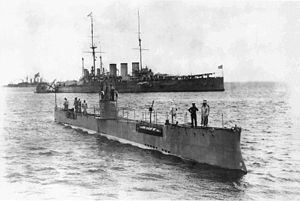Name Akula Type Submarine Launched 4 September 1907 Beam 3.73 m | Ordered 1906 Draft 3.4 m (11 ft 2 in) Length 56 m Builder Saint Petersburg | |
 | ||
Fate Sunk by mine, 28 November 1915 Displacement 370 long tons (380 t) surfaced
475 tons (471 m³) submerged | ||
Akula (Russian: Акула; meaning shark) was a submarine built for the Imperial Russian Navy. Akula saw service during World War I and sank in November 1915 after hitting a naval mine.
Contents
Design and construction
The boat was designed by Ivan Bubnov and was an amalgam of the previous Minoga and the Kasatka-class submarine designs. The design was presented to the Marine technical committee in late 1905 and was ordered in 1906.
Akula was built at the Baltic shipyard in Saint Petersburg. The vessel was launched on 4 September 1907.
Service history
Initially the boat was to use petrol engines but these were replaced by safer diesels. The boat's design was a single hull/ saddle tank type with a diving depth of 25 fathoms (45 meters (148 ft)).
Significant initial problems were experienced and the electric motor and propellers which needed to be replaced. Akula was the first Russian submarine able to cruise long distances. In 1912 Akula made the world's first multi-torpedo volley with five torpedoes.
She subsequently served in the Baltic Fleet during World War I making 16 patrols and unsuccessfully attacked the German coastal defense ship SMS Beowulf.
She struck a mine and sank near Hiiumaa in November 1915 on her 17th patrol. Akula lies about 30 meters (98 ft) below water. All 35 members of the crew died.
